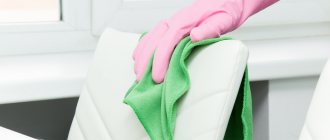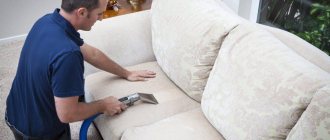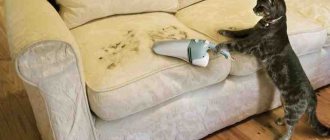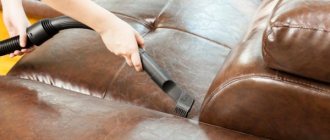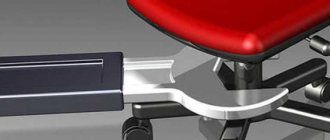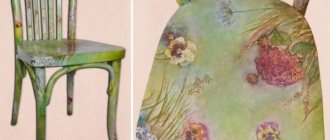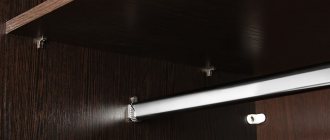How to properly care for your chair
During cleaning, you should not only treat the upholstery. In soft chairs, a large amount of dirt accumulates at the joints of the seat and sides, at the base of the backrest.
If armrests or cushions are removable, regularly clean these areas of debris and dust. In cases where this is not provided for by the design, use compact, crevice nozzles of a vacuum cleaner.
On computer chairs, it is necessary to periodically clean the wheels from accumulated dirt and hair. Debris interferes with the normal movement of the rollers. Don't forget to wipe down the armrests, counter and legs.
Some tips for cleaning chair upholstery yourself
The housewife can clean the upholstery on her own, without seeking specialized help. The most important thing is to choose a tool that is suitable for solving a specific problem, and rely on some simple tips:
- It is better to try to remove the dirt immediately before it has a chance to dry - this will increase the chances of completely removing the stains.
- When cleaning the room, try to protect the furniture upholstery from moisture, as stains may appear.
- The use of chemicals is not always justified; more often, for a good cleaning effect, you may only need a sponge with ordinary soap.
- In cases where the use of stain remover etc. is actually required, it is important not to rub them too hard, causing damage to the fabric fibers.
- When planning to use chemicals, you need to check their aggressiveness in some inconspicuous area. This way, you can be sure that no new stains or other marks will appear on the chairs after the cleaning procedure is completed.
- Dried dirt should not be soaked, but carefully cleaned off with a soft brush.
- When finishing cleaning, you need to thoroughly rinse all chemicals from the furniture upholstery so that the piece of furniture does not emit an unpleasant odor. In addition, the cleaning product should not be allowed to come into contact with children or pets.
Important! After finishing the cleaning procedure, you need to let the upholstery dry on its own. Chairs should not be dried using heaters or a hairdryer; not all materials can withstand the effects of high temperatures.
How to clean fabric upholstery
It is recommended that textile upholstery be vacuumed regularly. For delicate materials (velor, plush, velvet), it is better to wrap the nozzle in gauze. This will protect the pile from deformation. To refresh the color of furniture fabric and eliminate unpleasant odors, you can moisten gauze in an aqueous solution (per liter of liquid):
- table vinegar (1 tbsp.);
- lemon (juice of half a fruit);
- soda 2-3 tsp.
A heavily soiled fabric chair can be treated with a mixture of available products. Add per liter of water:
- 2 tbsp. l. baking soda;
- 8 tbsp. vinegar;
- 4 tbsp. glycerin;
- 4 tbsp. l. fairy or other dishwashing liquid.
Prepare the solution immediately before use.
- While the reaction is taking place, the foam is applied to the upholstery with soft, cleansing movements.
- Particular attention should be paid to stains and dirt and rub them with a sponge.
- Then remove the product with a cloth soaked in clean water and well wrung out.
- Vacuum the upholstery thoroughly.
To effectively clean a chair at home, use a washing vacuum cleaner.
It is important to use special upholstery products. Savings can lead to poor leaching of the composition and the appearance of streaks.
Need for cleaning
It doesn’t matter where the chair is located - it’s a kitchen, a bedroom, a living room, a children’s room, a hall - it always requires cleaning. Any upholstery accumulates not only dust and dirt, but also remnants of the natural biomaterial of people and animals. The situation is further complicated by the fact that drops of wine, blood, urine and other defects may appear on the furniture. Contamination will not only spoil the appearance of the furniture, but can also lead to an uncomfortable atmosphere, odors in the house, and in some cases, even to the development of allergies and skin irritation.
Routine cleaning at home will allow you to avoid expensive procedures in the salon. This service, if performed by specialists, can cost as much as a new chair, so it is better not to take it to extremes.
Features of caring for different types of upholstery
Even within one category of furniture fabrics (chenille, flock) there are lightweight and dense options. In order not to spoil an expensive item, it is worth asking when purchasing a chair whether it has a passport or instructions for caring for the upholstery. Generalized properties and features of furniture materials are given below.
Microfiber
The upholstery of this fabric is pleasant and stain resistant. It is coated with Teflon impregnation. It does not form “pellets” and does not shed.
Microfiber is often used in the production of models for offices and children's rooms. The material is inexpensive, with a velvety texture pleasant to the touch. Upholstery can be:
- vacuum with a soft brush attachment;
- easy to clean off dirt with a sponge;
- subject to gentle wet cleaning (without excessive wetting) using a soap solution and delicate detergents without chlorine.
Deep cleaning of microfiber computer chair upholstery should be carried out with foaming compounds and dry powder.
Do not treat the material with steam or hot water - bald spots may form. It is also undesirable to dry it near heating devices or with a hairdryer.
Velor, velvet
Armchairs with similar upholstery look cozy in the interior of the house, but require careful treatment and care. They cannot be cleaned:
- dry powder, the residues are difficult to remove from the pile;
- using active physical influence (the structure is deformed, bald spots are formed);
- aggressive agents, bleaches;
- water temperature above 30 °C;
- vacuum cleaner without a special soft attachment.
Only water-based products can be used to remove stains. To refresh the color, you can go in the direction of the pile with a soft cloth soaked in a vinegar solution. A special velor brush will help to straighten and fluff the pile, and clean the surface of hair and wool.
Fabric mesh
This inexpensive, breathable material is easy to care for. It is often chosen when arranging a workplace.
Regular cleaning of the mesh office chair upholstery does not require any effort. It is enough to regularly vacuum the upholstery and wipe it with a flannel cloth soaked in a soapy solution and wrung out well. For antiseptic treatment, once a month you can add a couple of drops of a disinfectant to the composition.
Chenille
A popular fabric due to its expensive appearance and durability. It is hypoallergenic and does not absorb odors.
It is recommended to clean chenille only using the dry method, using foaming compounds. The fabric is afraid of water. Snags easily form on the surface. Therefore, the chair cannot be cleaned with hard brushes.
Flock
Flock furniture is ideal for cat owners. This non-woven material is scratch resistant. During production, fibers are applied to an adhesive base.
It is recommended to vacuum the upholstery regularly. Once a week, you should wipe the surface of the chair with a slightly damp cloth. When caring for a flock chair, you should not allow:
- severe wetting (the base is destroyed);
- treatment with alcohol-containing preparations;
- exposure to temperatures above 40 °C.
Important! If the material is painted using the dry method (ask when purchasing), it is afraid of water. It can only be cleaned with powders and foams.
Effective ways to clean upholstered furniture
Upholstered furniture is the most susceptible to stains. This is especially true for light fleecy fabrics. But if you regularly devote time to cleaning, it can maintain its appearance unchanged for up to 10-12 years, even with constant use.
Soap solution
Rub 1 teaspoon of soap and mix until dissolved with a liter of water. Dip a napkin into the resulting solution and wipe in the direction of the pile. You can't use a lot of water.
Salt mixture
Mix a teaspoon of salt with a liter of water. A waffle towel is soaked in the mixture and applied to the area of contamination.
If you add the same amount of vinegar to the salt, you can remove more complex stains (the fabric should be light, vinegar can lighten dark ones).
Foams and powders for car interiors
The optimal method for routine cleaning is universal powders and foams for the car interior. It won’t take much time to wash a chair with them, but, alas, stains that are complex in structure cannot be removed.
Traditional methods
For stains of a certain nature, it is better to choose either a chemical product or use traditional methods. Naturally, the latter will be significantly cheaper.
Juice and wine stains
Removed with soda solution. If the stain is ingrained, then make a mixture of vinegar and ammonia in equal proportions. Soak a rag in it and apply it to the dirt for 3 minutes. You can try the salt method. Its essence is to pour a heap of salt onto the stain, wait 10 minutes, and then remove with a damp cloth. Remember that a fresh stain is easier to remove, so don’t delay cleaning.
Coffee Tea
Laundry soap is used. Mix a teaspoon with water, apply the composition to the surface for 1 minute and remove with a cloth.
Chewing gum
Removed by wiping with acetone. If it is frozen, you should freeze the pieces of ice in the freezer. They apply themselves to the chewing gum and literally tear it off the surface.
Fat
Grease stains are removed with salt. The place is sprinkled, wait 10 minutes, clean with a napkin. The method is not always effective - the fresher the stain, the more likely it is to remove it.
Dust and dirt
A soap solution made from laundry soap will do. They also take the usual special means for cleaning the car interior.
Urine
Urine stains are removed with a vinegar solution. Mix 1 tablespoon of 9 percent with a liter of water and apply it to the dirty areas using a napkin. Cleans with a damp cloth.
If the fabric is dark or colored, then use a weak solution of potassium permanganate or citric acid. Apply for an hour.
Lipstick
Sprinkle with salt and leave for 5 minutes. The mark is soaked in soapy water, washed clean and dried. Regular ammonia is also effective.
See also
22 best ways to clean cupronickel spoons at home
Felt pen or marker
Removed with acetone or ammonia. The area is washed away from the smell.
Nail polish
It can be removed, like the varnish itself, with acetone. In order not to increase the spread area, a cotton swab is used.
Ball pen
Cleaned with ammonia or ethyl alcohol. It's better to act immediately.
Blood
If it occurs, the area is quickly wetted with cold water. If the stain has dried, then the area is moistened with ice cubes and washed with a weak vinegar solution.
How to clean a leather chair
Before cleaning, check how the upholstery reacts to water. If it absorbs liquid, you should only use special household chemicals for this coating. If the surface repels moisture, you can clean a leather chair with a solution of 60 g of liquid laundry soap (easy to replace with baby soap shavings) and 2 liters of water.
- Use a dry soft sponge to remove dust, crumbs, small debris between the seat and back, and in other hard-to-reach places.
- Treat the surface with a cloth soaked in soapy water and wrung out well.
- Repeat the procedure with clean water.
- Wipe the surface dry with a well-absorbing cloth.
- Wipe the surface with leather conditioners, such as Turtle Wax Leather Cleaner & Conditioner
At home, store-bought polishes are replaced with olive oil, castor oil, baby cream, and Vaseline. Ink, coffee, and wine stains are removed immediately with alcohol.
When caring for a leather chair, you should not:
- treat with a hard bristle brush;
- rub the surface vigorously;
- allow contact with wet clothing (sweat causes darkened areas to appear);
- dry with a hairdryer (cracks will form);
- use products with abrasives.
Furniture made of leatherette and eco-leather requires similar care. You should not use aggressive stain removers or products containing petroleum products.
Homemade formulations
A good alternative to professional furniture care products are folk remedies. You can prepare them yourself from available ingredients. Car dealership cleaners work great on some stains.
Rules for selecting chair height for adults and children, standards
Soap solution
For 0.5 liters of warm water you need to take 100 grams of brown laundry soap, grated on a coarse grater. Stir everything until completely dissolved. With this composition you can clean an office or any other chair from grease stains, traces of tea, coffee, and juices in an hour. This composition is suitable for both fabric and leather upholstery. It is allowed to replace laundry soap with any other stain remover.
Salt mixture
This solution is only used for cleaning soft-coated products. To prepare, add a tablespoon of regular rock salt to a liter of warm water. The mixture is applied either manually using a damp cotton cloth or using a vacuum cleaner. In the second case, the brush is wrapped in a cloth soaked in the solution. The salt mixture can refresh the color of the product and clean its surface from dust.
Automotive facilities
Most automotive products are great for cleaning stains from computer chairs. The only drawback of such chemistry is the large number of fragrances. As a result of their use, the stain will be removed in a few minutes, and the pungent odor will disappear for many days. To remove dirt, you need to spray the product on a certain area, and after half an hour, remove the residue with a damp cloth.
Removing various types of contaminants
Stain removers effectively remove local stains from fabric upholstery:
- HG (Netherlands);
- Dr Beckmann;
- Udalix Ultra;
- domestic soap "Antipyatin".
Bleach, even oxygen bleach, should be used carefully and tested on a small area.
A common problem with old used chairs is grease. They are removed with a solution of ammonia, fairy or household liquid soap diluted with water. Try cleaning the armrests and dirty areas on the back with shaving foam.
Many factors influence the susceptibility of matter to contamination. But there are rules that apply in all cases.
- Remove excess immediately. Remaining fat - with a sorbent, moisture - with a towel.
- Apply the stain remover to a cotton swab or napkin, not to the upholstery.
- Treat the contaminated area from the edges of the stain to the center using scraping rather than rubbing movements.
- At the end of the procedure, blot the moisture.
- Use a vacuum cleaner to clean the entire surface of the seat or backrest.
Hydrogen peroxide will completely get rid of fresh blood. Water with diluted vinegar or lemon juice will help remove the stain and smell of cat urine. An alternative option is products purchased at a pet store.
Plan deep wet treatment for the warm season or in winter, when the room is warm, so that the furniture dries faster.
How to clean office furniture
Cleaning office furniture, such as tables, chairs, armchairs, armrests and others, is a must. It should be noted that if there is really a lot of furniture and there is no specialist in the company responsible for cleaning it, then it is wiser to resort to the services of a cleaning company. Folk remedies are not suitable, because they do not cope with all contaminants, but store-bought universal ones will do a better job.
Chemical cleaning of chairs
Why is cleaning a chair at home with the help of cleaning specialists a popular procedure? This piece of furniture is used very actively. As a result, it quickly becomes dirty; attempts to restore the original freshness and beauty on your own often end in failure.
Dry cleaners use the most effective extractor cleaning method in their work.
- The chair is vacuumed. Dirt, sand, and small particles are removed from all crevices.
- Professional household chemicals PROCHEM (England) and Chemspec (USA) are applied to the upholstery under high pressure.
- Using soft brushes, heavily soiled areas are treated.
- Properly selected reagents remove stains.
- Detergent, dirt particles, and excess moisture are removed by powerful Swiss equipment.
- The chair dries in natural conditions for several hours.
This procedure removes unpleasant odors, cleans not only the upholstery, but also the filling, and gets rid of possible dust mites and stubborn stains.
has been providing dry cleaning services in Moscow and the Moscow region since 2007. The company employs one and a half dozen specialists. All of them undergo mandatory vocational training. Responsibility to the client and affordable prices help us remain in demand in this service sector.
Recommendations for the procedure
To ensure that cleaning chairs from stains does not bring new troubles, you need to comply with certain conditions when carrying out the procedure, especially in a home environment. It is worth paying special attention to the upholstery fabric and frame material of the furniture being processed. Each fabric requires an individual approach to avoid damaging the appearance of the furniture.
Cleaning chairs from stains in the kitchen should be done using anti-grease agents. The chair is cleaned using dry detergents.
When cleaning furniture, you can not only get rid of dust and stains, but also damage it. To prevent this from happening, you must follow the following rules:
- If a chemical agent is used, it is advisable to cover the frame of the chair or armchair with film or paper so that the detergent does not get on it.
- Before using an unfamiliar substance, it is better to test it on an invisible part of the furniture, since many chemicals can change the color of the fabric, leave streaks or damage the pile. A day after testing, if no changes have occurred for the worse, you can begin cleaning the chair.
- Be sure to read the instructions and composition of the detergent before use.
- Do not use it under any circumstances if it contains chlorine. There is no need to rub detergent powders and liquids into stains. It is quite simple, according to the instructions for use, to treat the contaminated part and leave the detergent on the surface of the furniture, then wash it off. If the product can cope with contaminants, then additional physical effort is not needed. Using force when cleaning can also ruin the appearance of the furniture.
- It is recommended to clean the entire surface of the furniture at once, regardless of where the stains are. Partial cleaning will lead to the formation of streaks and a change in the shade of the surface.
- Carefully wash the stain remover from the furniture; its residue can cause an unpleasant odor in the future.
- Dirt that has dried to the surface is initially removed with a dry brush, and then the product and water are applied.
- After the cleaning procedure, the chairs should dry thoroughly. You cannot use an iron, hair dryer or other electrical appliances.
The materials used in the manufacture of chairs and armchairs are capricious. When cleaning chairs, you should not:
- Wash the frame with the same product as the upholstery.
- Use chlorine bleaches.
- Dry in the sun.
- Mix several detergents.
How to clean chair upholstery depending on the material
First, the components of the frame and upholstery of the chair are determined, since it is not possible to choose the desired method of work in any other way, because each material has its own characteristics. For example, the method of cleaning a tapestry may harm a velvet seat and so on.
According to experts, it is better to play it safe when cleaning and cover the entire frame of the chair and the floor underneath it each time, because one drop of cleaner is enough to harm the surface.
You should find in advance:
- Unnecessary newspapers or oilcloth;
- Scotch tape for painting.
Now you need to figure out which cleaning products can be used for a particular material.
Flock
This material is considered very practical and easy to use. You can clean such a fabric surface well using:
- Neutral detergent;
- Warm soapy water;
- Alcohol.
Attention! Do not scrape dried dirt on the flock or use aggressive chemicals.
Jacquard
Jacquard is chosen because it is not susceptible to fading in the sun for a long time, its colors remain bright, and it is resistant to temperature changes.
You can clean the jacquard surface according to the following plan:
- Soak the sponge in the soap solution;
- Rinse the jacquard upholstery fabric thoroughly;
- Wipe away any soap marks with dry cloths.
Important! A similar plan can be used to clean almost any material chosen for upholstery of a chair, with a few exceptions.
Velours
When cleaning velor, do not use chemicals or scrape dirt from the surface of the upholstery - it is very easy to damage such upholstery. If the chairs have velor upholstery, then the use of a vacuum cleaner is not allowed.
Microfiber
Microfiber upholstery must not be cleaned with hard brushes. Such aggressive cleaning will cause pellets to appear, and when removed, holes will appear. Microfiber is cleaned with a warm soapy solution using a sponge. A vinegar solution will help remove stains.
Important! A clothes steamer helps remove wrinkles and smooth out wrinkled surfaces on microfiber chairs.
Silk
This delicate material requires special treatment. Contaminated areas are treated with a sponge soaked in a weak solution of vinegar (at the rate of 1 tablespoon per liter of water). The use of soap is undesirable because silk fabric does not tolerate alkaline or other aggressive cleaning agents.
Attention! Violent friction, hot drying or steaming can cause great damage to silk upholstery.
Faux or genuine leather
Furniture surfaces made of materials such as leather require careful handling. As a rule, owners prefer special delicate care products. The main thing is not to forget about the following details:
- The more dirty, the longer the cleaning solution should remain on the stain;
- It is not necessary to wipe the surface of the upholstery dry - you can simply wipe off the stains;
- Aggressive chemicals are unacceptable; they harm the furniture surface.
Chenille
This material is recognized as wear-resistant and has a pleasant velvety structure. Chenille upholstery retains its original appearance for a long time, is not subject to fading and does not fade. However, it requires careful care.
- The contaminated surface must be carefully cleaned without the use of water or chemicals;
- When cleaning, you can use a vacuum cleaner or a soft-bristled brush; using a soap solution is permissible only as a last resort;
- When exposed to high temperatures, the fabric will be deformed.

